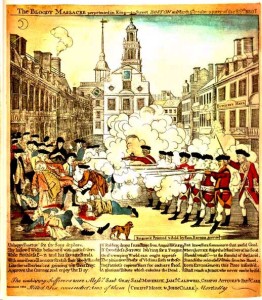
The Boston Massacre
The earliest military action that sowed the seeds for the American Revolution occurred on March 5, 1770, when Boston citizens stormed the Customs House in protest of British oppression. The mob threw snowballs at the British guards who opened fire on the protesters, killing five and wounding six others. The event came to be known as the Boston Massacre. Citizens were outraged. Boston supporters as well as Britain supporters recorded the act differently, attempting to influence opinion. The incident can be attributed as one of the reasons for the growth of state militia groups, as well as the turn of Colonial outlook against Britain. Donald E. Markle*
 Paul Revere, immortalized for his “midnight ride” was also a craftsman who wasted no time in producing a colorized engraving of his version of the event. The Boston Massacre Historical Society has some interesting details on Revere’s famous print.
Paul Revere, immortalized for his “midnight ride” was also a craftsman who wasted no time in producing a colorized engraving of his version of the event. The Boston Massacre Historical Society has some interesting details on Revere’s famous print.
When Paul Revere first began selling his color prints of “The Bloody Massacre perpetrated in King Street” in Boston, he was doing what any like-minded patriot with his talents in 1770 would have done. Only, Paul Revere did it faster and more expeditiously than anyone else, including two other artist-engravers who also issued prints of the Massacre that year. Â Paul Revere’s Engraving Explained
In addition to the event’s significance in fostering revolutionary spirit in American, it also provided a unique opportunity for a young John Adams to show his quality. In a move that can only be described as gutsy, Adams agreed to defend the British soldiers and civilians indicted by a grand jury for having fired upon the mob. Captain Preston and his men could have faced the death penalty if convicted. But they couldn’t find anyone to represent them. Enter John Adams.
The reasons for John’s acceptance of the case are difficult to assume. While he strongly believed that all men were entitled to a fair trial and that they deserved equal justice, he knew of the dangers to his practice and of the violence that the mob was capable therefore endangering his wife and young children. On the other hand, in the long term, he might be remembered as a man who put law above his personal beliefs.  The Boston Massacre Trials
Adams was masterful in his defense of the accused. Well aware of the sympathies of the jury, he was careful to shift the focus of the blame to London off the accused.
The jury acquitted six of the soldiers: William Wemms, William M’Cauley, Hugh White, William Warren, John Carrol and James Hartegan. The other two soldiers, Hugh Montgomery and Matthew Killroy, were found not guilty of murder but guilty of manslaughter, therefore escaping the death penalty. Both men invoked the “benefit of the clergy†allowing them to avoid a long imprisonment. They had their thumbs branded with the letter “Mâ€, leaving a permanent mark so that they would not receive a lenient treatment in the future. The Boston Massacre Trials
Thus, the Boston Massacre was not only a signal event that led to the Revolutionary War and the Royal Governor’s evacuation of troops from Boston, but also launched the career of John Adams. Adams would go on to serve with distinction in Continental Congress and as the nation’s second president.
 The posts are coming!
The posts are coming!

2 comments
I like this article very much. Few remember that Paul Revere was a silversmith, and I had forgotten the trial. Thanks!
[Reply]
Thanks Ann, I’m glad you enjoyed it.
[Reply]
Leave a Comment